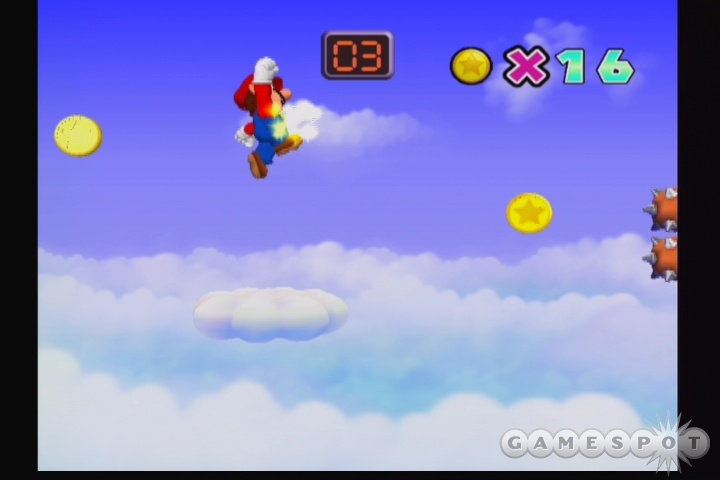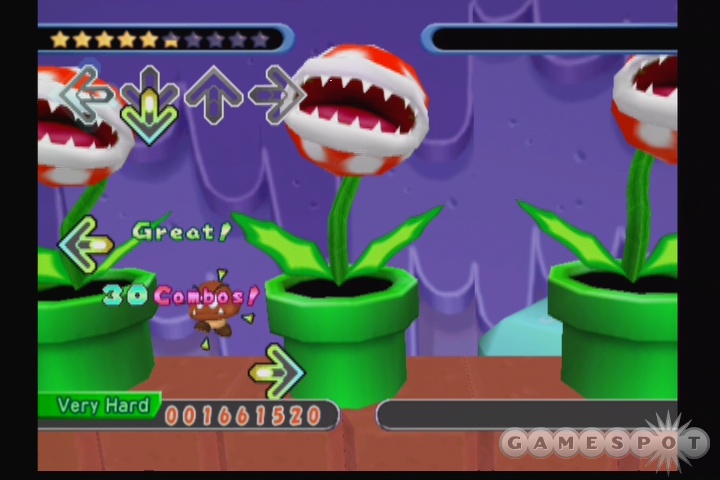Dance Dance Revolution: Mario Mix Updated Hands-On - Story, Mini-Games, and Music
We take another opportunity to get our feet on the next Dance Dance Revolution game, which stars none other than Mario.
Konami's popular arcade dancing franchise has made its way over to both the PS2 and the Xbox several times, but Dance Dance Revolution: Mario Mix is the first game to include GameCube owners in on the action. The game, accompanied by a GameCube controller-turned-dance mat, lets players control some of their favorite Nintendo characters by stepping on the mat's four arrows in time with the music. We sat down--or stood up, rather--with a version of the game to see how closely it approximated DDR, and to see what Mario and the gang were up to now that they've finally made the big leap from Nintendo-produced games.
At the beginning of the game, a shadowy figure, who resembles Waluigi (and who we later find out is Waluigi), makes off with the mysterious music keys, which we (not surprisingly) haven't heard of before. Apparently, this causes the constituents of the Mushroom Kingdom all kinds of trouble, so order must be restored...somehow. The way to do this is through the story mode. In this version, we had the opportunity to select between Mario and Luigi to play through the story. It all begins with a frantic toad, who needs help in recovering the lost music keys or certain destruction will surely befall the Kingdom. Being the ever-agreeable plumber that he is, Mario (or Luigi) quickly assents, and the two head off to find adventure. Adventure pops its head just a few steps out the door before the duo's progress is halted by a mysterious river, which, as the toad explains, might be able to be dispelled by the magic of dance. Makes sense to us too.

And so the game progresses, interspersing story with danceable numbers and rhythm-based minigames. Since you're most likely going to have the mat in front of you for the dancing, you will find it a little annoying to keep stepping on the A button to bypass the story sequences. Other than that, the story, which is kind of silly, does a good job of breaking up the gameplay. The minigames are well-suited to the controller, as you'll be able to play games like Whack-a-Goomba, which requires you to step on the arrow that corresponds to the location of four goomba's popping their heads out of warp pipes. Another minigame called Flagpole Leap closely resembles the Power Pad track-and-field game, which makes players run back and forth as fast as possible and then jump for a high score.
The music numbers are almost all entirely based on songs from previous Mario games, and we saw music credited to Super Mario Bros. 1-3, Dr. Mario, Mario Party 5, and Mario Kart: Double Dash, among other games. Though it's Mario music, it's remixed with fast-paced beats or more relaxed jazzy tunes. This is quite a turn from the traditional DDR musical fare, which generally consists of licensed techno and dance artists, and a whole slew of poppy DDR songs made specifically for the game. However, some things are still distinctly DDR, like the catcalling announcer who shouts accolades and admonishes over the music while you play.
It's clear, from the version we saw, that the game is not necessarily meant to appeal to DDR fanatics. While DDR games have gotten harder over time to account for a fan base that keeps getting better, this game is significantly easier than DDR. There are four modes, the most difficult of which is "super hard." Super hard is the equivalent of DDR's standard mode. The game gets a little more difficult in this mode, because in addition to the arrows, there are randomly placed goombas and koopa troopas that fly up the screen. You step on them for additional coin bonuses at the end of the level. The coins work just like in Mario games: once you get 100 coins, you get an additional life, and as long as you have enough lives to continue, you can keep playing through the story. Each level has four songs, with a few minigames in between, and it culminates in a dance-off boss battle at the end. Once that's done, you've earned a music key, and given that there are four keys in total, you'll have to go through the same process four times. Along the way, you can use your coins to purchase items for the gameplay. A one-up mushroom will automatically give you another life, the max drink increases your dance meter all the way, and the mystery drink increases or decreases your dance meter randomly.

The Nintendo-branded mat that comes with the game is very similar to the Konami mat from DDR. The substantial difference is that the upper diagonals represent the B and A buttons, and the lower two diagonals are filled with a lot of warning text. Where Select and Start would be on the PS2 or Xbox mat, there is Z and Start, respectively. We were quite pleased to see that the generic silhouette that is typically on the mat's center square has been replaced with a figure of a break-dancing Mario on the Nintendo mat.
There are 18 songs available in the beginning, and as with DDR, you don't have to play through the story mode; you can alternatively play any song in the free mode, or play any of the 12 minigames in minigame mode. We found this to be the most exciting prospect of all, since many of the modes reminded us of the old Power Pad days. If anything, DDR: Mario Mix reminds us that it has been far too long since the pioneer of mat controllers revisited its old stomping grounds, literally. We look forward to seeing more of this game as it nears release at the end of October.
Got a news tip or want to contact us directly? Email news@gamespot.com
Join the conversation